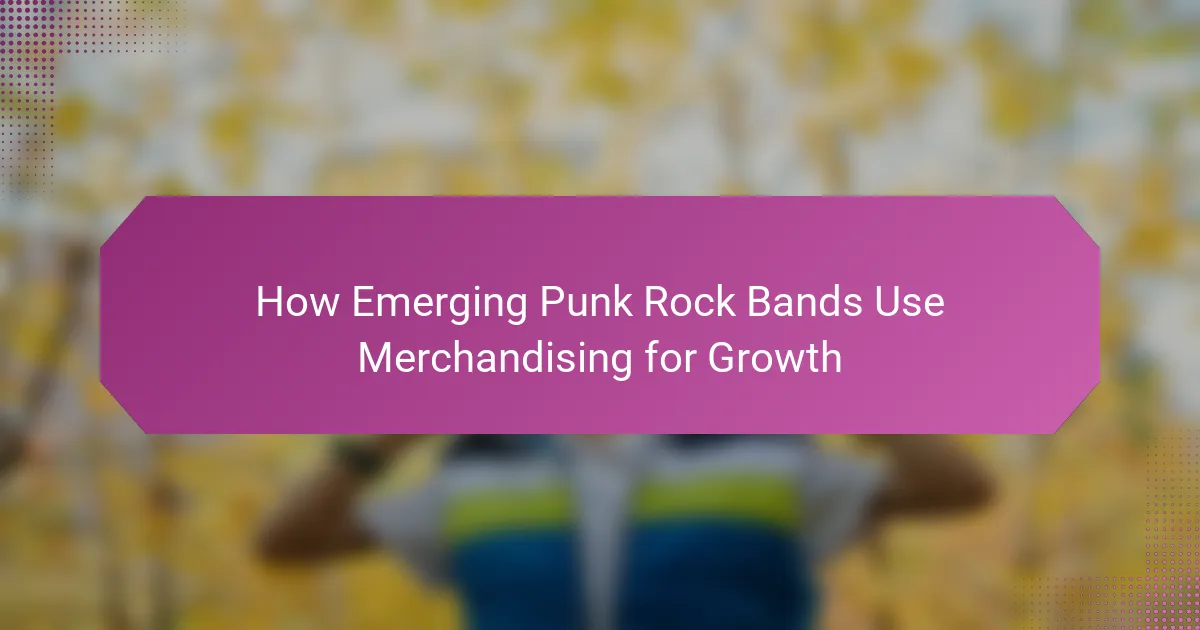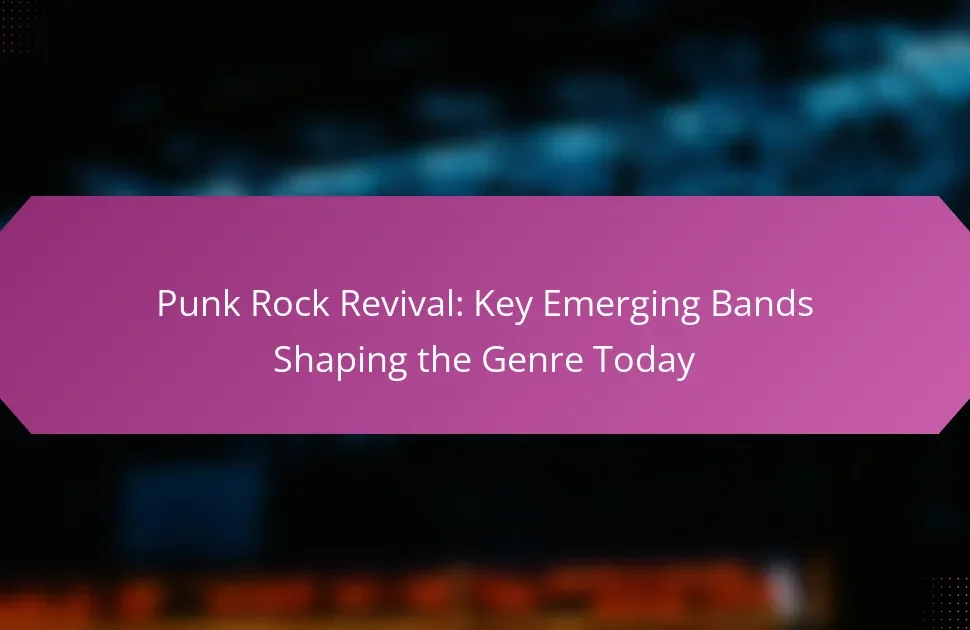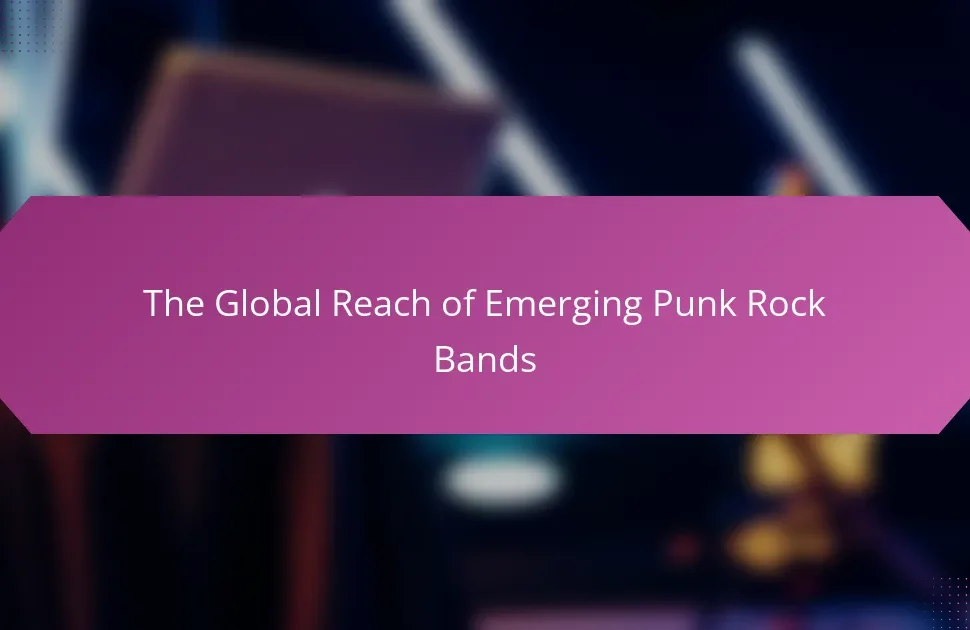Emerging punk rock bands face challenges in gaining visibility and financial support in a competitive music industry. They leverage unique merchandise designs to enhance brand identity and foster fan loyalty. Limited edition items create urgency and exclusivity, driving sales and community engagement. Social media platforms like Instagram and TikTok amplify their reach, enabling targeted marketing and direct fan interactions.
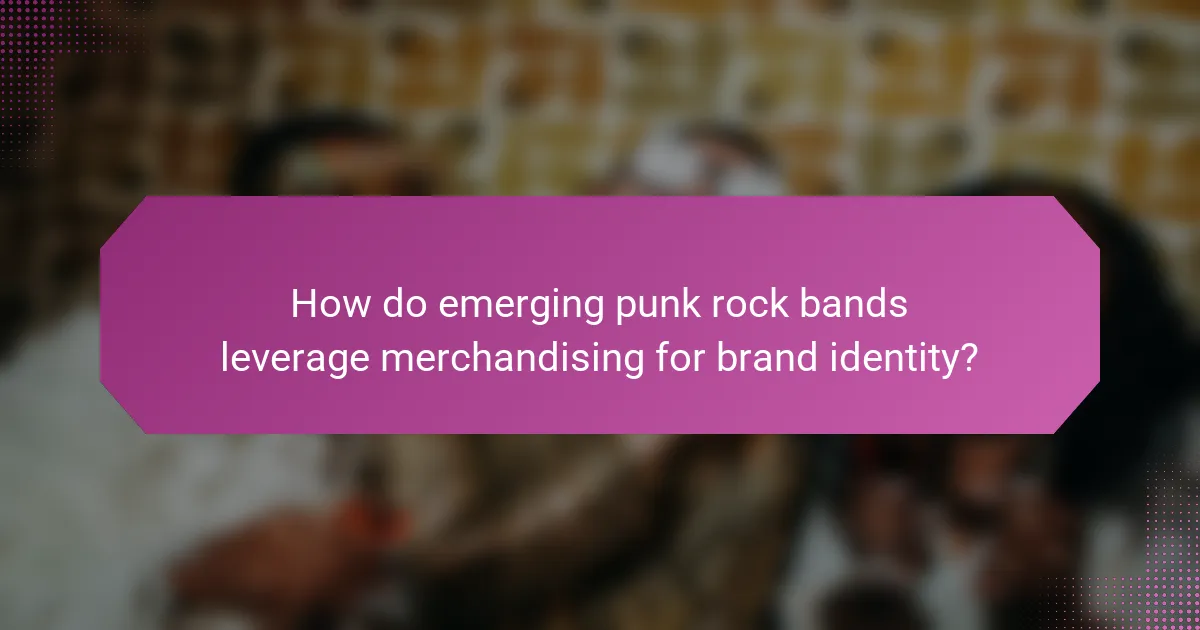
How do emerging punk rock bands leverage merchandising for brand identity?
Emerging punk rock bands leverage merchandising to enhance brand identity and foster fan loyalty. They create unique designs that reflect their music and ethos. Merchandise serves as a tangible connection, allowing fans to express their support.
Additionally, bands often use limited edition items to create urgency and exclusivity. This strategy not only boosts sales but also reinforces a sense of community among fans. By integrating their merchandise with social media campaigns, these bands amplify their reach and engagement.
Merchandising also provides financial support for touring and recording, essential for growth. As a result, it becomes a vital tool for establishing and maintaining a distinct brand identity in the competitive music landscape.
What types of merchandise are most effective for punk rock bands?
Emerging punk rock bands find various merchandise types effective for growth. Apparel, such as t-shirts and hoodies, serves as a primary revenue source and promotes brand visibility. Accessories like pins and patches foster community engagement and loyalty. Vinyl records and CDs appeal to collectors, enhancing the band’s unique identity. Additionally, posters and artwork create a visual connection with fans. Each merchandise type strengthens the band’s presence and supports financial sustainability.
How does merchandise contribute to fan engagement and loyalty?
Merchandise significantly enhances fan engagement and loyalty by creating a tangible connection to emerging punk rock bands. Unique items like limited-edition apparel foster a sense of belonging among fans. Additionally, exclusive merchandise can serve as a symbol of support, deepening emotional ties to the band. The act of purchasing and wearing band merchandise also promotes visibility, encouraging fans to share their passion within their social circles. This visibility can lead to increased word-of-mouth promotion, further expanding the band’s reach and audience.
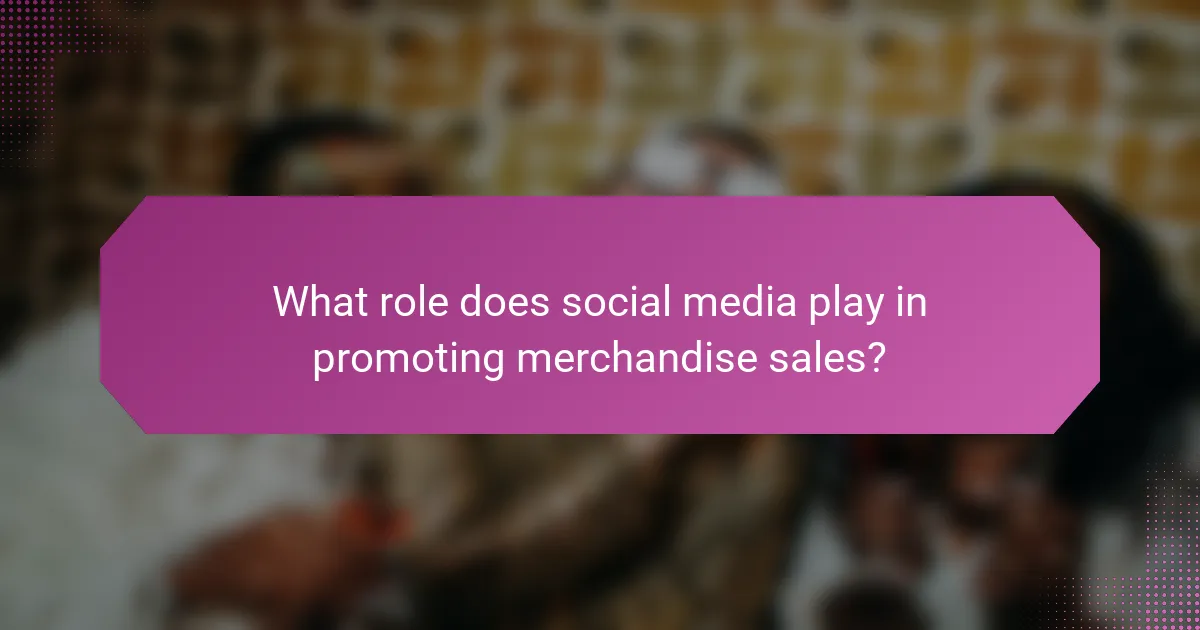
What role does social media play in promoting merchandise sales?
Social media significantly boosts merchandise sales for emerging punk rock bands by enhancing visibility and engagement. Platforms like Instagram and TikTok allow bands to showcase their unique designs and connect with fans directly. This interaction fosters community and loyalty, leading to increased merchandise purchases. Additionally, social media enables targeted marketing, helping bands reach specific demographics effectively. Bands can leverage user-generated content to promote their merchandise, creating a sense of authenticity and relatability that drives sales.
Which platforms are most popular for merchandising among punk rock bands?
Social media platforms like Instagram and Facebook are most popular for merchandising among punk rock bands. These platforms allow bands to engage directly with fans, showcase merchandise, and drive sales through targeted advertising. Additionally, Bandcamp serves as a dedicated space for music sales and merchandise, enhancing visibility for emerging bands. The unique attribute of these platforms lies in their ability to facilitate community-building, which is crucial for punk rock culture.
How can bands use social media to create buzz around new merchandise?
Emerging punk rock bands can effectively use social media to create buzz around new merchandise by engaging directly with their fanbase. They should leverage platforms like Instagram and Twitter to showcase behind-the-scenes content, sneak peeks of new merchandise, and limited-time offers.
Creating interactive posts, such as polls or contests, encourages fan participation and generates excitement. Collaborating with influencers within the punk rock scene can further amplify reach and credibility. Regular updates about merchandise drops, combined with visually appealing content, can keep fans informed and eager to purchase.
Utilizing hashtags relevant to the punk rock community can enhance visibility, ensuring the merchandise reaches a broader audience. Additionally, sharing customer photos of merchandise can foster a sense of community and encourage others to buy.
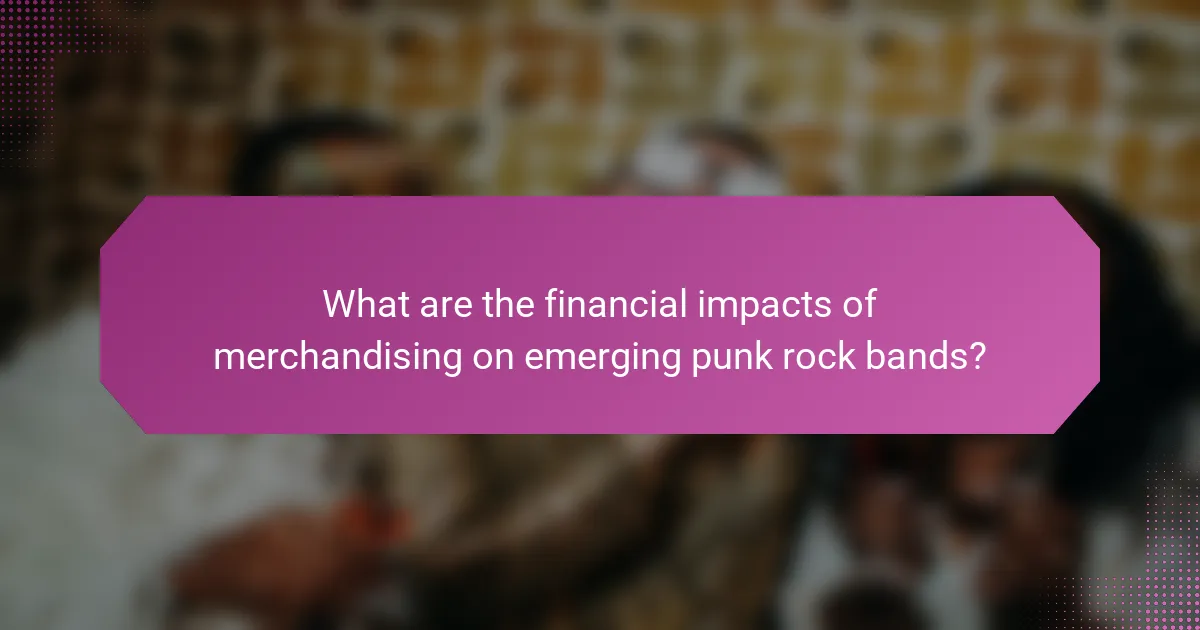
What are the financial impacts of merchandising on emerging punk rock bands?
Merchandising significantly boosts emerging punk rock bands’ financial growth by diversifying income sources. Bands can generate revenue through merchandise sales, enhancing their visibility and fan engagement.
Merchandise, including apparel and accessories, creates a direct connection with fans, fostering loyalty. This connection often translates into increased concert attendance and streaming numbers, further amplifying revenue streams.
Additionally, successful merchandising can lead to unique opportunities, such as collaborations with brands, which can provide substantial financial benefits. The unique attribute of limited-edition items can create urgency among fans, driving sales and enhancing brand identity.
Overall, effective merchandising strategies are vital for emerging punk rock bands to achieve sustainable growth in a competitive music industry.
How do merchandise sales compare to ticket sales for revenue generation?
Merchandise sales often surpass ticket sales for emerging punk rock bands, contributing significantly to revenue generation. Bands leverage unique merchandise to engage fans and create additional income streams. Effective branding and appealing designs enhance merchandise appeal, leading to higher sales. This strategy allows bands to sustain growth and expand their reach in a competitive music landscape.
What are the costs associated with producing and selling merchandise?
The costs associated with producing and selling merchandise for emerging punk rock bands include production, shipping, marketing, and sales expenses. Production costs vary based on materials and design complexity. Shipping fees depend on the distribution method and distance. Marketing expenses can include social media promotions and event sponsorships. Sales expenses might involve platform fees for online sales. Understanding these costs helps bands strategize for profitability and growth.
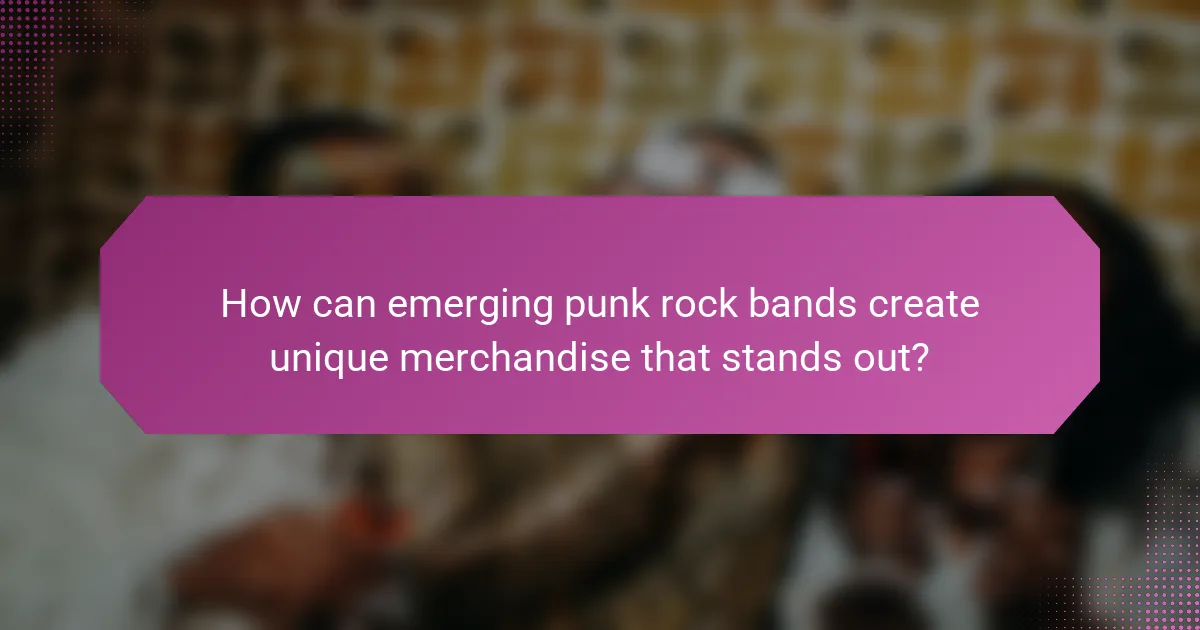
How can emerging punk rock bands create unique merchandise that stands out?
Emerging punk rock bands can create unique merchandise by embracing their identity and connecting with their audience. They should focus on originality, using bold designs and limited editions to capture attention. Collaborating with local artists can enhance creativity and authenticity. Additionally, incorporating sustainable materials can appeal to eco-conscious fans. Engaging fans through social media for feedback on merchandise ideas fosters community and loyalty. Finally, offering personalized items, such as custom patches or fan art, can create a unique selling point that distinguishes their brand.
What design elements resonate with punk rock fans?
Emerging punk rock bands often use bold graphics, vintage aesthetics, and DIY elements in their merchandising to connect with fans. These design elements reflect the rebellious spirit of punk culture. Unique designs, often featuring provocative or politically charged imagery, resonate deeply with punk rock fans. Additionally, the use of sustainable materials in merchandise appeals to the values of many fans, enhancing brand loyalty.
How can bands collaborate with artists for exclusive merch designs?
Bands can collaborate with artists for exclusive merch designs by leveraging unique artistic styles and fan engagement. This partnership enhances brand identity and creates limited-edition items that appeal to dedicated fans. Collaborations can include artwork that reflects the band’s music themes, ensuring a cohesive aesthetic. Additionally, successful collaborations often involve promotional strategies that highlight the artist’s involvement, driving sales and increasing visibility for both parties.
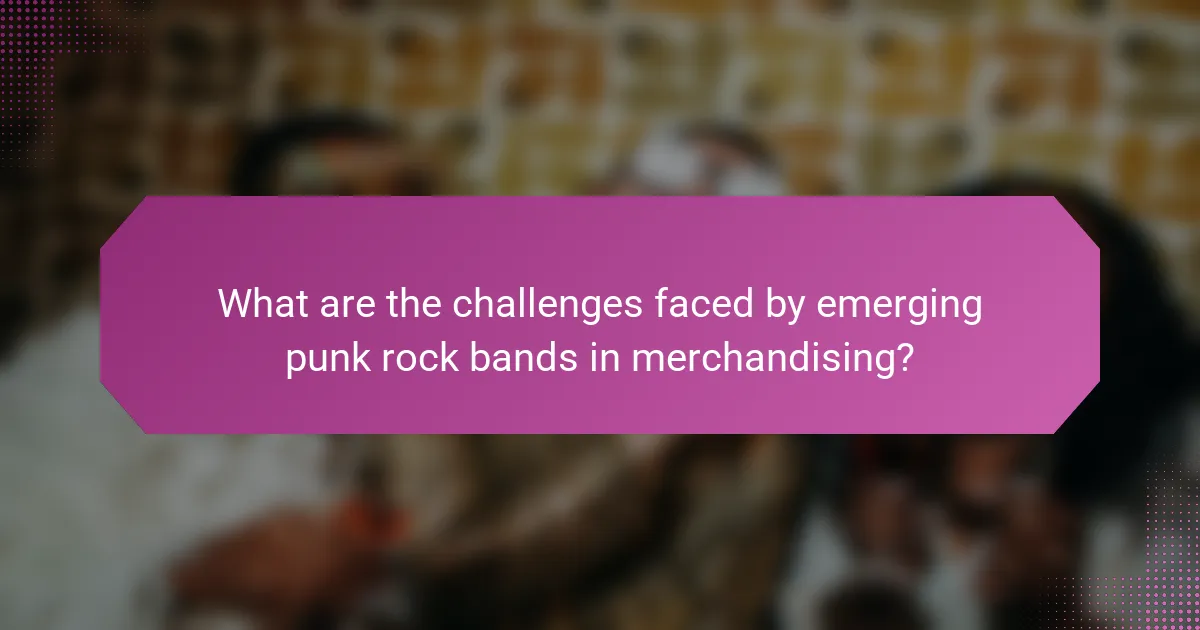
What are the challenges faced by emerging punk rock bands in merchandising?
Emerging punk rock bands face significant challenges in merchandising that can hinder their growth. Limited budgets restrict their ability to produce high-quality merchandise. Additionally, competition from established brands makes it difficult to gain visibility. Many bands struggle with marketing their products effectively, often lacking the expertise or resources needed. Furthermore, understanding their target audience’s preferences is essential but can be complex. Lastly, managing inventory and sales logistics poses a challenge, especially for bands without dedicated support.
How do supply chain issues affect merchandise availability?
Supply chain issues significantly reduce merchandise availability for emerging punk rock bands. Disruptions in production and distribution lead to delays and limited stock. Bands may struggle to meet fan demand, impacting sales and growth. This scarcity can hinder brand visibility and fan engagement, ultimately affecting their market presence.
What legal considerations should bands be aware of when selling merchandise?
Emerging punk rock bands should consider copyright, trademark registration, and sales tax compliance when selling merchandise. Copyright protects original designs, while trademarks secure brand identity. Sales tax regulations vary by state and can impact pricing strategies. Understanding these legal aspects helps prevent disputes and ensures smooth operations.
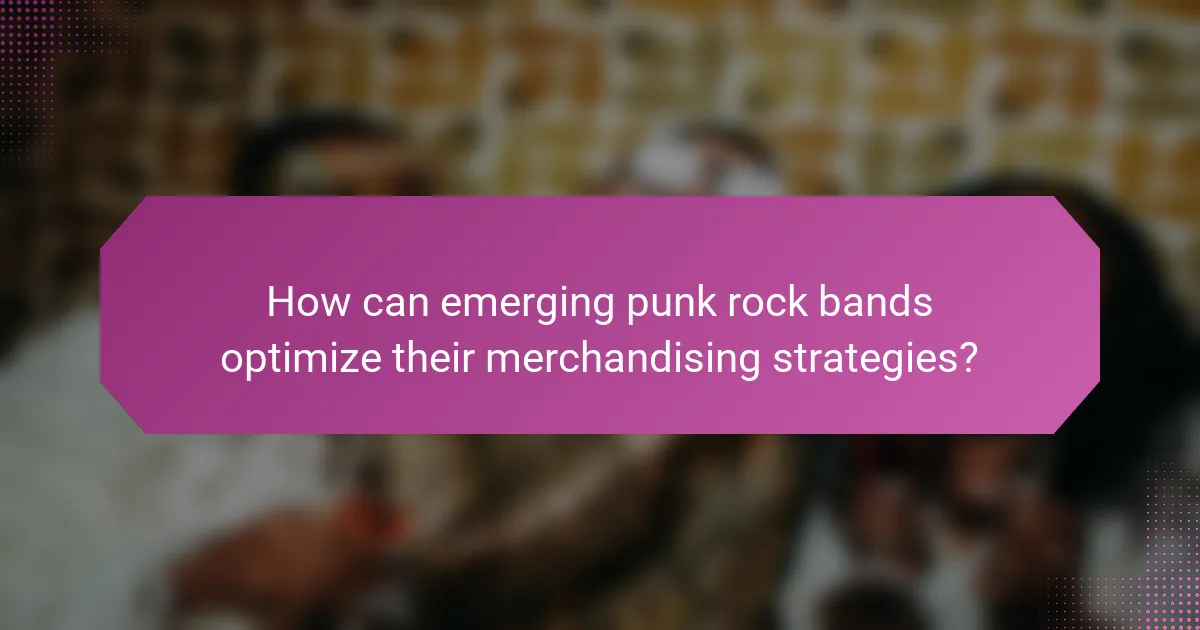
How can emerging punk rock bands optimize their merchandising strategies?
Emerging punk rock bands can optimize their merchandising strategies by focusing on unique designs, limited editions, and fan engagement. Unique merchandise, such as custom apparel and accessories, helps create a distinct brand identity. Limited edition items drive urgency and exclusivity, encouraging fans to make purchases quickly. Engaging fans through social media and live events fosters loyalty and increases merchandise sales. Collaborating with local artists for designs can also enhance the brand’s authenticity and appeal within the punk community.
What best practices should bands follow for effective merchandising?
Emerging punk rock bands should prioritize authenticity, quality, and strategic promotion in their merchandising efforts. Authentic designs resonate with fans and reflect the band’s identity. High-quality products enhance customer satisfaction and encourage repeat purchases. Utilizing social media platforms for promotion expands reach and engages with the audience effectively. Collaborating with local artists for unique merchandise can create a distinctive appeal. Finally, offering limited edition items can drive urgency and exclusivity, boosting sales and brand loyalty.
Which common mistakes should bands avoid in their merchandising efforts?
Emerging punk rock bands should avoid overextending their merchandise offerings, neglecting quality, failing to engage their audience, and lacking a cohesive brand identity. These mistakes can hinder growth and alienate fans.
Overextending merchandise can dilute a band’s brand, making it harder for fans to connect. Prioritizing quality ensures products reflect the band’s image and values, which builds trust. Engaging with the audience through social media or events fosters loyalty and drives sales. A cohesive brand identity across all merchandise strengthens recognition and appeal.
